Clancy Tucker's Blog, page 172
October 18, 2017
19 October 2017 - FAMOUS LAST WORDS

FAMOUS LAST WORDS
G'day folks,
Welcome to some more famous last words from the rich and infamous.
34. Thomas Hobbes – Writer“I am about to take my last voyage, a great leap in the dark.”
35. George Washington – US President“It is well, I die hard, but I am not afraid to go.”
36. Noel Coward – Writer“Goodnight my darlings, I’ll see you tomorrow.”
37. Walter De La Mare – Writer“Too late for fruit, too soon for flowers.”
38. George Gordon Noel Byron, 6th Baron Byron – Writer“Now I shall go to sleep. Good night.”
39. Grover Cleveland – US President“I have tried so hard to do the right.”
40. Dylan Thomas – Poet“I’ve had eighteen straight whiskies, I think that’s the record…”
41. Dominique Bouhours – French grammarian“I am about to — or I am going to — die: either expression is correct.”
42. Ernesto Che Guevara“I know you have come to kill me. Shoot coward, you are only going to kill a man.”
43. John Barrymore Actor“Die? I should say not, dear fellow. No Barrymore would allow such a conventional thing to happen to him.”
44. Harry Lillis “Bing” Crosby – Singer/Actor“That was a great game of golf, fellers.”
45. Charles Darwin – English naturalist & Geologist“I am not the least afraid to die.”
46. H. G. Wells – Novelist“Go away, I’m all right!”
47. Lady Mary Wortley Mantagu“It’s all been very interesting.”
48. Frederic Chopin – Composer“The earth is suffocating . . . Swear to make them cut me open, so that I won’t be buried alive.”

Clancy's comment: So, what would your last words be?
I'm ...


Published on October 18, 2017 13:44
October 17, 2017
18 October 2017 - FACTS ABOUT DOMESTIC CATS
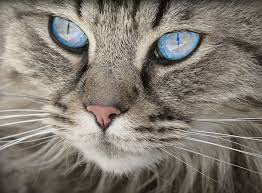
FACTS ABOUT DOMESTIC CATS
G'day folks,
Many of you will enjoy this post. The domestic cat is a small, typically furry, carnivorous mammal. They are often called house cats when kept as indoor pets or simply cats when there is no need to distinguish them from other felids and felines.
Like their wild relatives, domestic cats are natural hunters able to stalk prey and pounce with sharp claws and teeth.
Quick FactsType: MammalDiet: CarnivoreLife span: Up to 20 yearsSize: 71 cmWeight: 2.3 to 9 kgHabitat: Urban and suburban areasRange: WorldwideScientific name: Felis catus Cats have been shown to have their own individual personalities. Cats enjoy acute hearing and can detect an extremely broad range of frequencies. They can detect frequencies from 55 Hz up to 79 kHz, a range of 10.5 octaves, which includes higher pitched sounds than humans and even dogs can hear. They are particularly effective hunters at night, when their light-reflecting eyes allow them to see much better than their prey. Cats communicate by marking trees, fence posts, or furniture with their claws or their urine. These scent posts inform others of a cat’s home range. Most cats are nimble and agile, and their long tails aid their outstanding balance. The flexible tail has as many as 28 vertebrae. Cats have a mobile backbone that allows them to rotate the front half of the spine through an angle of 180 degrees in relation to their back half.

The front paws are capable of a wide range of tasks from opening doors to pouncing on prey.The cat’s tongue has backwards-facing spines about 500 micrometres long, which are called papillae. These are quite rigid, as they contain keratin. These spines allow cats to groom themselves by licking their fur, with the rows of papillae acting like a hairbrush. Some cats, particularly longhaired cats, occasionally regurgitate hairballs of fur that have collected in their stomachs from grooming. These clumps of fur are usually sausage-shaped and about two to three centimeters long.Cats conserve energy by sleeping more than most animals, especially as they grow older. The daily duration of sleep varies, usually 12–16 hours, with 13–14 being the average. Some cats can sleep as much as 20 hours in a 24-hour period.During sleep cats experience short periods of rapid eye movement sleep accompanied by muscle twitches, which suggests that they are dreaming.Every time a cat awakes, it automatically stretches to flex every muscle and sinew to its fullest extent and restore circulation. Domestic cats use many vocalizations for communication, including purring, trilling, hissing, growling, snarling and several different forms of meowing.

Their types of body language, including position of ears and tail, relaxation of whole body, and kneading of paws, are all indicators of mood. The tail and ears are particularly important social signals in cats, with a raised tail acting as a friendly greeting. Tail raising also indicates the cat’s position in the group’s social heirarchy, with dominant individuals raising their tails less often than subordinate animals. Nose-touching is also a common greeting and may be followed by social grooming, which is solicited by one of the cats raising and tilting its head.
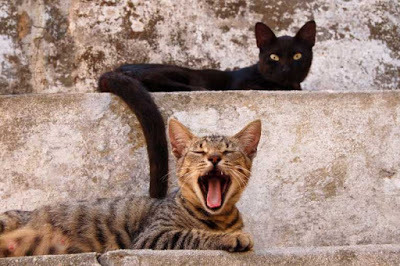
Cats are generally affectionate animals and love being spoiled and petted, when they will roll and purr appreciatively. Thoroughly contented cats will happily sleep alongside their owners, where they enjoy the feeling of warmth and security.
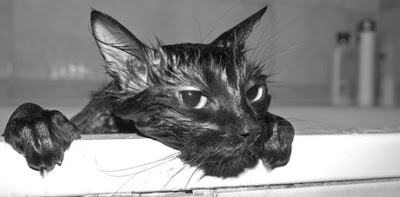
It has been scientifically proven that owning cats is good for our health and can decrease the occurrence of high blood pressure and related illnesses.
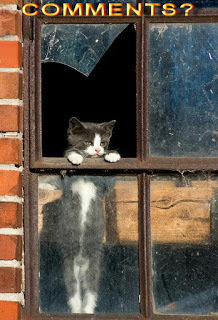
Clancy's comment: They say you never own a cat. It owns you. And, if you want to find a cat in a house, just leave an open box out. Just sayin' ...I'm ....


Published on October 17, 2017 13:18
October 16, 2017
17 October 2017 - AGENT ORANGE
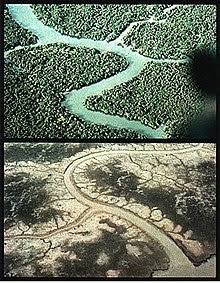
AGENT ORANGE
G'day folks,
It took two generations and a lot of heartache among the Vietnam veteran community, but the VA's “presumptive list” of diseases that are caused by exposure to Agent Orange now includes everything from non-Hodgkin lymphoma, prostate cancer, and multiple myeloma to Parkinson's disease and ischemic heart disease.
Agent Orange was a powerful herbicide used by U.S. military forces during the Vietnam War to eliminate forest cover and crops for North Vietnamese and Viet Cong troops. The U.S. program, codenamed Operation Ranch Hand, sprayed more than 20 million gallons of various herbicides over Vietnam, Cambodia and Laos from 1961 to 1971. Agent Orange, which contained the deadly chemical dioxin, was the most commonly used herbicide. It was later proven to cause serious health issues—including cancer, birth defects, rashes and severe psychological and neurological problems—among the Vietnamese people as well as among returning U.S. servicemen and their families.

Operation Ranch Hand
During the Vietnam War,the U.S military engaged in an aggressive program of chemical warfare codenamed Operation Ranch Hand.
From 1961 to 1971, the U.S. military sprayed a range of herbicides across more than 4.5 million acres of Vietnam to destroy the forest cover and food crops used by enemy North Vietnamese and Viet Cong troops.
U.S. aircraft were deployed to douse roads, rivers, canals, rice paddies and farmland with powerful mixtures of herbicides. During this process, crops and water sources used by the non-combatant native population of South Vietnam were also hit.
In all, American forces used more than 20 million gallons of herbicides in Vietnam, Laos and Cambodia during the years of Operation Ranch Hand. Herbicides were also sprayed from trucks and hand-sprayers around U.S. military bases.
Some military personnel during the Vietnam War era joked that “Only you can prevent a forest,” a twist on the U.S. Forest Service’s popular fire-fighting campaign featuring Smokey the Bear.
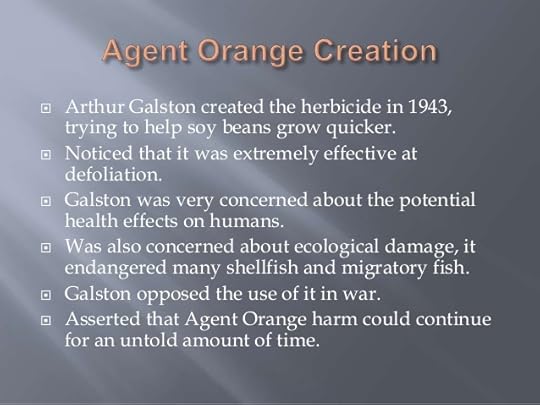
What Is Agent Orange?
The various herbicides used during Operation Ranch Hand were referred to by the colored marks on the 55-gallon drums in which the chemicals were shipped and stored.
In addition to Agent Orange, the U.S. military used herbicides named Agent Pink, Agent Green, Agent Purple, Agent White and Agent Blue. Each of these—manufactured by Monsanto, Dow Chemical and other companies—had different chemical chemical additives in varying strengths.
Agent Orange was the most widely used herbicide in Vietnam, and the most potent. It was available in slightly different mixtures, sometimes referred to as Agent Orange I, Agent Orange II, Agent Orange III and “Super Orange.” More than 13 million gallons of Agent Orange was used in Vietnam, or almost two-thirds of the total amount of herbicides used during the entire Vietnam War.

Dioxin in Agent Orange
In addition to Agent Orange’s active ingredients, which caused plants to “defoliate” or lose their leaves, Agent Orange contained significant amounts of 2,3,7,8-tetrachlorodibenzo-p-dioxin, often called TCDD, a type of dioxin.
Dioxin was not intentionally added to Agent Orange; rather, dioxin is a byproduct that’s produced during the manufacturing of herbicides. It was found in varying concentrations in all the different herbicides used in Vietnam.
Dioxins are also created from trash incineration; burning gas, oil and coal; cigarette smoking and in different manufacturing processes such as bleaching. The TCDD found in Agent Orange is the most dangerous of all dioxins.
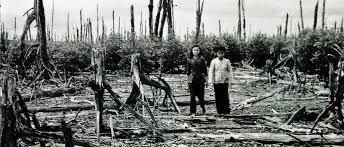
Effects of Agent Orange Because Agent Orange (and other Vietnam-era herbicides) contained dioxin in the form of TCDD, it had immediate and long-term effects.
Dioxin is a highly persistent chemical compound that lasts for many years in the environment, particularly in soil, lake and river sediments and in the food chain. Dioxin accumulates in fatty tissue in the bodies of fish, birds and other animals. Most human exposure is through foods such as meats, poultry, dairy products, eggs, shellfish and fish.
Studies done on laboratory animals have proven that dioxin is highly toxic even in minute doses. It is universally known to be a carcinogen (a cancer-causing agent).
Short-term exposure to dioxin can cause darkening of the skin, liver problems and a severe acne-like skin disease called chloracne. Additionally, dioxin is linked to type 2 diabetes, immune system dysfunction, nerve disorders, muscular dysfunction, hormone disruption and heart disease.
Developing fetuses are particularly sensitive to dioxin, which is also linked to miscarriages, spina bifida and other problems with fetal brain and nervous system development.
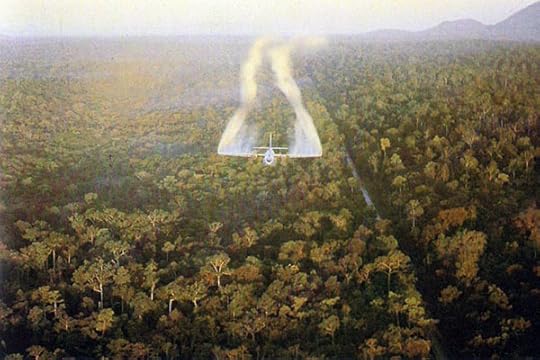
Veteran Health Issues and Legal Battle
Questions regarding Agent Orange arose in the United States after an increasing number of returning Vietnam veterans and their families began to report a range of afflictions, including rashes and other skin irritations, miscarriages, psychological symptoms, type 2 diabetes, birth defects in children and cancers such as Hodgkin’s disease, prostate cancer and leukemia.
In 1988, Dr. James Clary, an Air Force researcher associated with Operation Ranch Hand, wrote to Senator Tom Daschle, “When we initiated the herbicide program in the 1960s, we were aware of the potential for damage due to dioxin contamination in the herbicide. However, because the material was to be used on the enemy, none of us were overly concerned. We never considered a scenario in which our own personnel would become contaminated with the herbicide.”
In 1979, a class action lawsuit was filed on behalf of 2.4 million veterans who were exposed to Agent Orange during their service in Vietnam. Five years later, in an out-of-court-settlement, seven large chemical companies that manufactured the herbicide agreed to pay $180 million in compensation to the veterans or their next of kin.
Various challenges to the settlement followed, including lawsuits filed by some 300 veterans, before the U.S. Supreme Courtconfirmed the settlement in 1988. By that time, the settlement had risen to some $240 million including interest.
In 1991, President George H.W. Bushsigned into law the Agent Orange Act, which mandated that some diseases associated with Agent Orange and other herbicides (including non-Hodgkin’s lymphoma, soft tissue sarcomas and chloracne) be treated as the result of wartime service. This helped codify the VA’s response to veterans with conditions related to their exposure to Agent Orange.
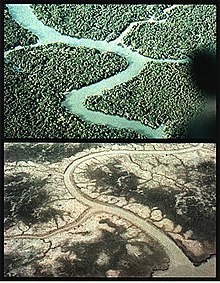
Legacy of Agent Orange in Vietnam In addition to the massive environmental devastation of the U.S. defoliation program in Vietnam, that nation has reported that some 400,000 people were killed or maimed as a result of exposure to herbicides like Agent Orange. In addition, Vietnam claims half a million children have been born with serious birth defects, while as many 2 million people are suffering from cancer or other illness caused by Agent Orange.
In 2004, a group of Vietnamese citizens filed a class-action lawsuit against more than 30 chemical companies, including the same ones that settled with U.S. veterans in 1984. The suit, which sought billions of dollars worth of damages, claimed that Agent Orange and its poisonous effects left a legacy of health problems and that its use constituted a violation of international law. In March 2005, a federal judge in Brooklyn, New York, dismissed the suit; another U.S. court rejected a final appeal in 2008, causing outrage among Vietnamese victims of Operation Ranch Hand and U.S. veterans alike.
Fred A. Wilcox, author of Scorched Earth: Legacies of Chemical Warfare in Vietnam, told the Vietnamese news source VN Express International, “The U.S. government refuses to compensate Vietnamese victims of chemical warfare because to do so would mean admitting that the U.S. committed war crimes in Vietnam. This would open the door to lawsuits that would cost the government billions of dollars.”
 Clancy's comment: 13 million gallons of Agent Orange later, and who won this bloody war? Not to mention, who made squillions of dollars selling this stuff to the US Army? Disgraceful, but war is hell - any war!
Clancy's comment: 13 million gallons of Agent Orange later, and who won this bloody war? Not to mention, who made squillions of dollars selling this stuff to the US Army? Disgraceful, but war is hell - any war!I'm ...

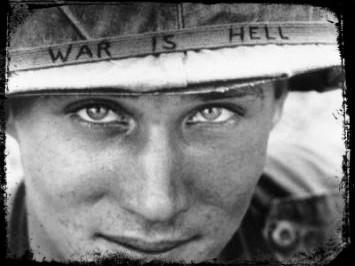
Published on October 16, 2017 12:58
October 15, 2017
16 October 2017 - JERRY’S JUNK IN KENTUCKY
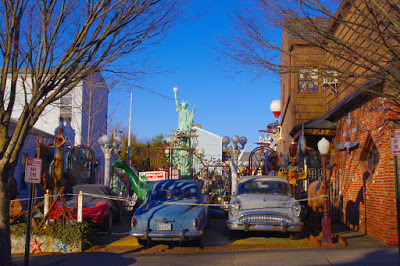
JERRY’S JUNK IN KENTUCKY
G'day folks,
Here is another hoarder story.
Staring out at you from behind those rusty gates; thousands of tightly packed, unwanted objects from the past sit in an eerie silence, almost as if they might just come alive as soon as you turn your back. Each and every single one has been collected by Kentucky’s King of Junk, who has made a temporary home for them in his wild and tangled fortress.

Most people have heard of Louisville, Kentucky for hosting “the most exciting two-minutes in sports”, aka, The Kentucky Derby. The first Saturday in May, locals and celebrities alike sip on mint juleps and watch the best horses in the world race. But most people don’t venture around Kentucky’s biggest city to find its quirky gems.

Louisville’s Clifton neighbourhood is eclectic. Antique shops, used bookstores, and vintage clothing boutiques line the street along with some of the best restaurants in town. As the road dips down towards the Ohio River, a technicolor junk yard sits on the corner of Frankfort Avenue and Williams Street. Most people don’t actually notice while driving by. Even the locals have become blind to the sight of Jerry’s junk yard of weird and whacky memorabilia.

Jerry Lotz is a retired machinist and iron worker who started his collection in 1946 at the age of eight. Along with his main “display,” he owns four other houses in the neighbourhood, all equally filled with “junk”.
Driving his 1951 Studebaker, he visits flea markets to collect items for his “buy/ sell/ trade” business, though he tends to buy more than sell. “I can’t sell it,” he said. “I wouldn’t know where to get more.”

Jerry is somewhat elusive, and lives on the upper floor of the house; though if you do happen to catch him, he’s friendly and approachable and he can talk for hours. Visitors have reported that this zany old man has approached them while they gawked at his collection and taken them on tours that lasted anywhere from twenty minutes to two hours. One commented that the funniest part of their tour was that he dragged around a rake the entire time, making it almost impossible to hear him!

If you do happen to catch Jerry and he gives you the tour, you may end up with a souvenir like a lucky horse shoe. If you don’t see him hanging around, give a yell, “Hey Jerry!” Chances are, he’ll soon appear, ready to share his story.
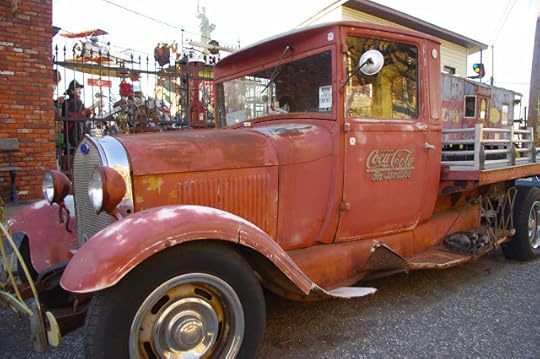

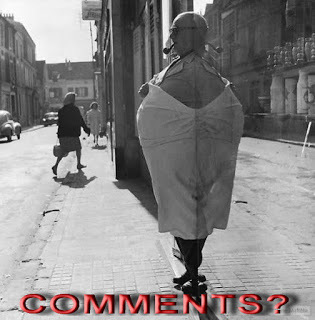 Clancy's comment: I often wonder what will happen to all this stuff when Jerry passes away.
Clancy's comment: I often wonder what will happen to all this stuff when Jerry passes away.I'm ...


Published on October 15, 2017 13:45
October 14, 2017
15 October 2017 - MAGDEL ROETS - GUEST AUTHOR
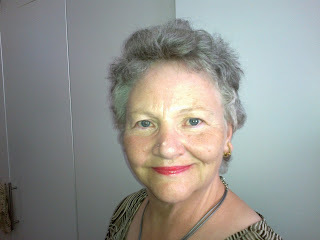
MAGDEL ROETS- GUEST AUTHOR -
G'day folks,
Today, I interview an author who is powering ahead with new works.
Welcome, Magdel ...
1. TELL US A LITTLE ABOUT YOURSELF AND YOUR WRITING JOURNEY.I wrote my first story when I was twelve years old. I was never read by anyone but me and ended up in the trash. Twenty years ago I tried again, but not seriously. I just scribbled some thoughts, put them in order and a story emerged. A magazine rejected the manuscript, but years later a publisher accepted it. The book was released in 2011.
Later I got an idea for an English story and took about fifteen months to finish it. Now to find a publisher. It was not easy or quick, but long story short: I found one on LinkedIn. Or rather he found me. Perhaps we found each other. He offered to have a look at my book, I sent it by email, a week later I signed a contract and less than two months from there my book was released. And it did not cost me a fortune, like with other publishers. Now, a year and a half later, I have three books published with more underway. If this is not Divine intervention, I wouldn't know what is.
At least one of my Short stories in Afrikaans has been included in a book together with other writer's stories. The book will be released soon.
2. WHEN AND HOW DID YOU BECOME A WRITER?The moment I realised I was born to write, was the moment I became a writer. I knew writing was in me and the stories had to get out. I knew for sure I was a writer when I held my first printed book in my hands.
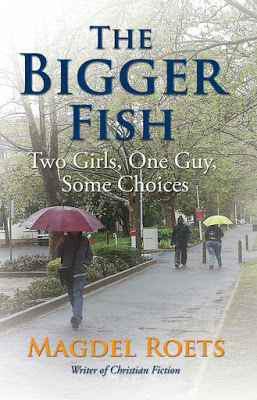
3. WHAT TYPE OF PREPARATION DO YOU DO FOR A MANUSCRIPT? DO YOU PLAN EVERYTHING FIRST OR JUST SHOOT FROM THE HIP?The only preparation I do, is sitting down with a tall, strong coffee and switch on my computer. From there everything starts to run.
4. WHAT DO YOU ENJOY MOST ABOUT BEING A WRITER?I get much pleasure when people enjoy one of my books and tell me they look forward to reading the next one. When this happens, I thank Yahweh for using me to bless people by using the talent He gave me.
5. WHAT IS THE HARDEST THING ABOUT BEING A WRITER?Not knowing if my latest book will be a success. Hope is all I have until I get feedback in whatever form.
6. WHAT WERE YOU IN A PAST LIFE, BEFORE YOU BECAME A WRITER?A wannabe writer.
7. WHAT IS YOUR GREATEST WRITING ACHIEVEMENT?By the grace of Yahweh, three books have been released in the last nineteen months.
8. WHAT ARE YOU WORKING ON AT THE MOMENT?A poetry book is almost done, a short story is half way through, another novella is on its way and then there is my next full length novel which I am working on whenever I get a chance. There is also a piece of non-fiction in the pipeline, but some research is still to be done.
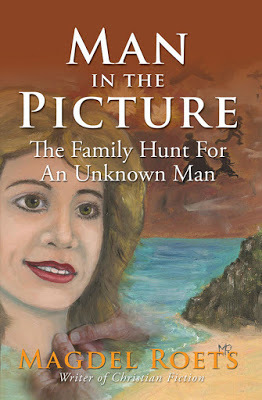
9. WHAT INSPIRES YOU?People inspire me in the way they react to happenings in their lives.
10. WHAT GENRE DO YOU WRITE?Christian fiction. Since I am a follower of Yeshua, I cannot get myself to write anything other than from Christian perspective.
11. DO YOU HAVE ANY TIPS FOR NEW WRITERS?Sit down and do it. Scribble down every thought that comes to you and see where it leads. There is something to say about planning and plotting, but don't be bound by it. Too strict plotting might kill a good story.
12. DO YOU SUFFER FROM WRITER’S BLOCK?Only when there is a deadline.
13. DO YOU HAVE A PREFERRED WRITING SCHEDULE?No. I write whenever I can fit it in.
14. DO YOU HAVE A FAVOURITE WRITING PLACE? I have a little "office" where I keep nothing but my computer and my writing paraphernalia.
15. WHAT IS YOUR GREATEST JOY IN WRITING?To create something meaningful, but also entertaining. Something that will be a blessing in every way.
16. WHO IS YOUR FAVOURITE AUTHOR AND WHY?John Grisham. His stories are well written, excellently plotted with many twists and surprises to keep the pages turning. I like the humour, a very important element in any book. The best part is that you can read most of his books numerous times without getting bored.
17. WHAT’S THE GREATEST COMPLIMENT YOU EVER RECEIVED FROM A READER?A reader told me that long after she finished the book, the characters stayed with her and she wanted to know when she may expect the follow-up.

15. WHAT WAS THE WORST COMMENT FROM A READER?"I, um, like the book. What's the title again?"
16. WRITERS ARE SOMETIMES INFLUENCED BY THINGS THAT HAPPEN IN THEIR OWN LIVES. ARE YOU? I do learn from experience how people react to different situations and apply those insights when I create a character and place him/her in a specific situation.
17. OTHER THAN WRITING, WHAT ELSE DO YOU LOVE?Painting. I made paintings to use in the cover images of my latest two books. I also enjoy gardening, walking on a beach and, of course, reading.
18. DID YOU HAVE YOUR BOOK / BOOKS PROFESSIONALLY EDITED BEFORE PUBLICATION?I did most of the editing myself, but I might get it done professionally in future.
19. DESCRIBE YOUR PERFECT DAY.Start with a tall coffee and rusks on the patio, (depending on the weather), while waiting for the sun to come up. A quick session at the open air gym followed by a hearty breakfast. After that a few hours among the paint and brushes, salad for lunch, relax with a good book for an hour or two or a long walk on the beach, a light supper, watch a good movie or DVD and then end the day by writing until the sun comes up again, provided I'd be allowed to sleep through the next day.
20. IF YOU WERE STUCK ON A DESERT ISLAND WITH ONE PERSON, WHO WOULD IT BE? WHY? I agree with the person who answered this same question choosing Mc Guyver, because he'd be able to get me home somehow.
21. WHAT WOULD YOU SAY IF YOU HAD THE CHANCE TO SPEAK TO WORLD LEADERS?I'd tell them to surrender their lives to Yeshua and start ruling according to the laws of Yahweh.
22. WHAT ARE YOUR PLANS FOR THE FUTURE?Keep on writing, painting and living to the glory of our Creator.
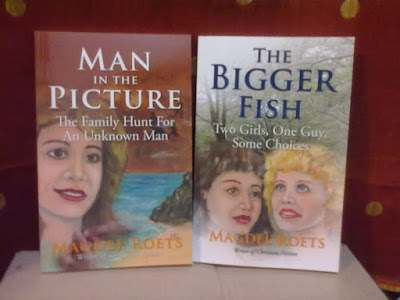
23. WHAT ARE YOUR VIEWS ON BOOK TRAILERS? DO THEY SELL BOOKS?I haven't made use of them, but I'm sure they form an important part of the marketing process. I do consider trying it at some point.
24. DO YOU SEE YOURSELF IN ANY OF YOUR CHARACTERS?Perhaps there is a little bit of me in most of my characters, just like there is a little bit of me in my children.
25. DOES THE PUBLISHING INDUSTRY FRUSTRATE YOU?It used to, until I found the company that is now doing my publishing.
26. DID YOU EVER THINK OF QUITTING?Just about a million times. I get discouraged easily, but God picks me up every time and tell me to stop the self-pity and get on with the job.
27. WHAT WAS YOUR FAVOURITE MANUSCRIPT TO WRITE? WHY?I can honestly not choose one over the other. I love them all, in different ways, just as I love my children in different ways
28. HOW WOULD YOU DEFINE ‘SUCCESS’ AS A WRITER?A writer is successful when he/she makes some positive impact on his readers, either intellectually, emotionally or in any other way that gives the reader something to take home.
29. WHAT SHOULD READERS WALK AWAY FROM YOUR BOOKS KNOWING? HOW SHOULD THEY FEEL?They should know there is hope and that all things work out for the good of those who keep themselves hidden in Yeshua.
30. WOULD YOU LIKE TO HAVE YOUR BOOKS MADE INTO MOVIES? EVER WRITTEN A SCREENPLAY?I have never written a screenplay, but my big dream is to see my books as movies on the big screen.
31. HOW MUCH THOUGHT GOES INTO DESIGNING A BOOK COVER?There are quite a number of things to consider when designing a cover. It must be eye catching. The image must reflect the theme and somehow convey tone by touching the right emotion. Background colour is very important as well as lettering and enough, but concise information about content.

32. WHAT’S YOUR ULTIMATE DREAM?It is to finish at least one series and see them being filmed, maybe even play a small role in at least one of the movies. Something like Aunt Emma in "My Father's Will".
33. WRITING IS ONE THING. WHAT ABOUT MARKETING YOU, YOUR BOOKS AND YOUR BRAND? ANY THOUGHTS?Writing is difficult. Marketing is far worse.
34. ARE YOUR BOOKS SELF-PUBLISHED?I self-published on Smashwords before I found this great publisher in Alaska. Now my books get published in a most professional way.
35. DESCRIBE YOURSELF IN FIVE WORDS.Serious, sincere, creative, determent procrastinator.
36. WHAT PISSES YOU OFF MOST?Hypocrisy, flattery and envy.
37. WHAT IS THE TITLE OF THE LAST BOOK YOU READ? GOOD ONE?"What if I go?"
38. WHAT WOULD BE THE VERY LAST SENTENCE YOU’D WRITE?It is written, now read it.
39. WHAT WOULD MAKE YOU HAPPIER THAN YOU ARE NOW? CARE TO SHARE?A family celebration with my children with their spouses and my grandchildren, all in one place at the same time.
40. ANYTHING YOU’D LIKE TO ADD?Nothing of the above would be worth anything if it did not glorify our Saviour
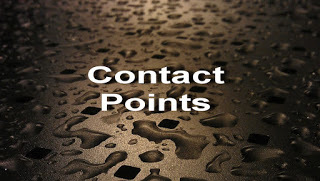
MORE ABOUT MY BOOKS
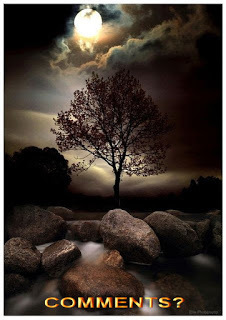
Clancy's comment: Well done, Magdel. Keep writing and being inspired.
I'm ...


Published on October 14, 2017 13:22
October 13, 2017
14 October 2017 - Amazing Facts About the Caribou

Amazing Facts About the Caribou
G'day folks,
Here are some very interesting facts about a great survivor.
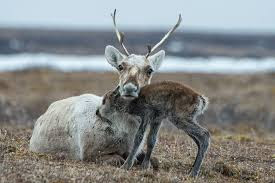
They are the only deer in which male and females both have antlers—though these are larger in the males than females and only some females have them.
They live in huge herds as both resident and migratory populations. As summer approaches, many reindeer herds of tens or even hundreds of thousands head north along well trodden annual routes. Some populations migrate the furthest of any terrestrial mammal, traveling up to 5,000 km a year. During migration, herds of cows (females) leave several weeks before the males, who follow with yearling calves from the previous birthing season. Normally travelling about 19–55 km a day while migrating, the reindeer can run at speeds of 60–80 km/h. At the end of their journey, they spend the summer feeding on the abundant grasses and plants of the tundra. In these rich grounds, an adult reindeer can eat 5 kg of food each day. Cows have one calf each year, which can stand after only a few minutes and move on with its mother by the next day. When the first snows fall each year, they turn back south to spend the winter in more sheltered climes and survive by feeding on lichens.
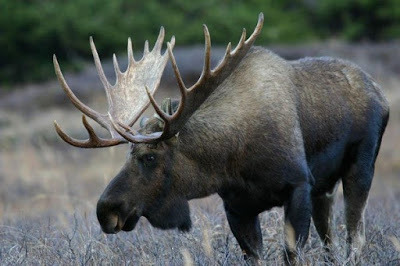
Reindeer thrive in cold climates. They have hooves that allow them to easily walk on snow and ice unlike deer and moose. Their hollow hairs give them extra insulation from the extreme cold and give increased buoyancy allowing them to easily float. A reindeer can swim at speeds up to 10 km/h and migrating herds will not hesitate to swim across a large lake or broad river.Tendons in the Reindeers’ feet slip over the bones producing a clicking sound. During blizzard conditions, detection of the sound is used to keep the herd together. Reindeer have large hooves that are big enough to support the animal’s bulk on snow and to paddle it efficiently through the water. The hoof’s underside is hollowed out like a scoop and used for digging through the snow in search of food. Its sharp edges give the animal good purchase on rocks or ice.Reindeer have no internal body clock. The animals are missing a “circadian clock” that influences processes including the sleep-wake cycle and metabolism. This enables them to better cope with the extreme Arctic seasons of polar day, when the sun stays up all day, and polar night, when it does not rise. · The Grey Wolf is the most effective natural predator of adult reindeer, especially during the winter. Brown Bears and (in the rare cases where they encounter each other) polar bears also prey on reindeer of all ages but are most likely to attack weaker animals such as calves and sick deer. Golden eagles prey on calves and are the most prolific hunter on calving grounds. Wolverine will take newborn calves or birthing cows, as well as (less commonly) infirm adults.
· Reindeer have been in retreat from humans for decades and numbers are plummeting around the world. The first global review of their status has found that populations are declining almost everywhere they live. It is considered that healthy and abundant caribou populations will not survive in many regions without setting aside large tracts of land free from industrial development.
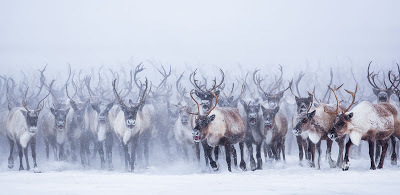
· Several groups of indigenous Arctic and Sub-Arctic people hunt wild reindeer and herd semi-domesticated reindeer (for meat, hides, antlers, milk and transportation).
· Some scientists believe that the first people to cross the Bering Land Bridge into North America may have been in pursuit of migratory caribou herds. · Even far outside its range, the reindeer is well known due to the myth, probably originating in early 19th century America, in which Santa Claus’ sleigh is pulled by flying reindeer, a popular secular element of Christmas. These reindeer were first named in the 1823 poem “A Visit from St. Nicholas” where they are called Dasher, Dancer, Prancer, Vixen, Comet, Cupid, Dunder, and Blixem. Dunder was later changed to Donder and—in other works—Donner (in German, “thunder”), and Blixem was later changed to Bliksem, then Blitzen (German for “lightning”). Some consider Rudolph as part of the group as well, though he was not part of the original group but was added by Robert L. May in 1939 as “Rudolph the Red-Nosed Reindeer”.
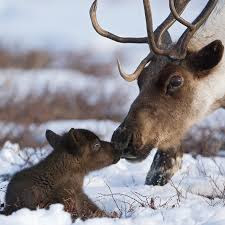

Clancy's comment: Very tasty as well.
I'm ...


Published on October 13, 2017 12:59
October 12, 2017
13 October 2017 - QUOTES WORTH READING
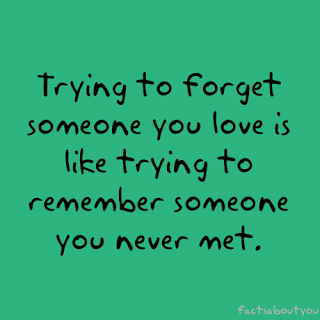
QUOTES WORTH READING
G'day folks,
Time for some more worthwhile quotes to get you fired up for the day.


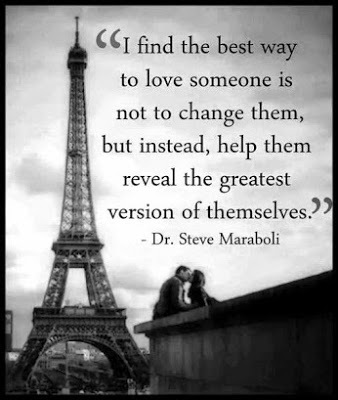


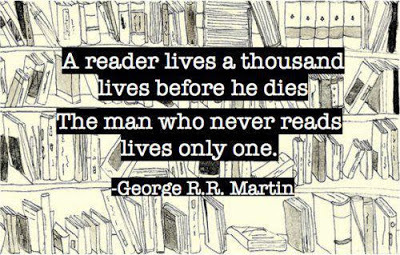


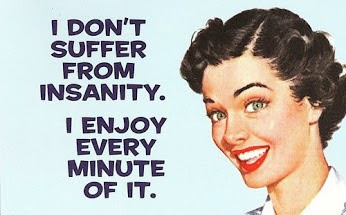


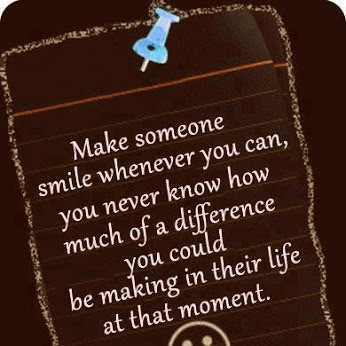



Clancy's comment: I love the one about sanity. Sounds like any creative person.
I'm ...
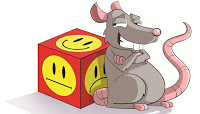

Published on October 12, 2017 14:56
October 11, 2017
12 October 2017 - A BURIED FERRARI
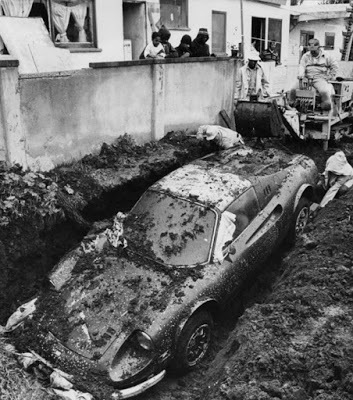
A BURIED FERRARI
G'day folks,
Ever found a Ferari in your front garden?
I n February, 1978, a Dino 246 GTS was discovered by a group of kids digging in the front yard of their home in Los Angeles. After much speculation and media attention with very few leads, it was eventually concluded that the car, which had been declared stolen four years prior by its owners, had been buried there by the thieves. The-then current residents claimed no part in it and amazingly, no neighbours had reported seeing anything strange (like someone burying a Ferrari) back in 1974.

The car was returned to the insurance company that had covered the owners’ loss several years earlier and it was put up for private auction. The Dino went to a young mechanic for $9,000 who managed to fully restored it despite extensive damage (from being buried underground for several years and from the botched removal job from its muddy grave). Since then, historical enthusiasts have been unable to track down the mechanic as he has since moved garage and never left a forwarding address. Three decades after it was unearthed, the Ferrari has yet to be listed on any Dino registry. Is it still on the road? Could the disappearing mechanic have been the one that buried it in the first place? So much mystery still revolves around the buried Dino.

 Clancy's comment: What next will we find buried?
Clancy's comment: What next will we find buried?I'm ...
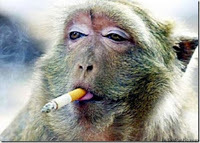

Published on October 11, 2017 13:34
October 10, 2017
11 October 2017 - FIDEL CASTRO

FIDEL CASTRO
G'day folks, Fidel Alejandro Castro Ruz was a Cuban revolutionary and politician who governed the Republic of Cuba as Prime Minister from 1959 to 1976 and then as President from 1976 to 2008.
Cuban leader Fidel Castro (1926-2016) established the first communist state in the Western Hemisphere after leading an overthrow of the military dictatorship of Fulgencio Batista in 1959. He ruled over Cuba for nearly five decades, until handing off power to his younger brother Raúl in 2008. During that time, Castro’s regime was successful in reducing illiteracy, stamping out racism and improving public health care, but was widely criticized for stifling economic and political freedoms. Castro’s Cuba also had a highly antagonistic relationship with the United States–most notably resulting in the Bay of Pigs invasion and the Cuban Missile Crisis. The two nations officially normalized relations in July 2015, ending a trade embargo that had been in place since 1960, when U.S.-owned businesses in Cuba were nationalized without compensation. Castro died on November 25, 2016, at 90.
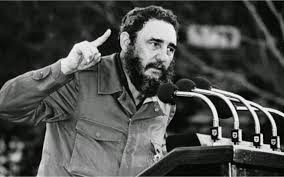
Fidel Castro: Early Years
Castro was born on August 13, 1926, in Birán, a small town in eastern Cuba. His father was a wealthy Spanish sugarcane farmer who first came to the island during the Cuban War of Independence (1895-1898); his mother was a domestic servant for his father’s family who bore him out of wedlock. After attending a couple of Jesuit schools–including the Colegio de Belén, where he excelled at baseball–Castro enrolled as a law student at the University of Havana. While there, he became interested in politics, joining the anti-corruption Orthodox Party and participating in an aborted coup attempt against the brutal Dominican Republic dictator Rafael Trujillo.
In 1950, Castro graduated from the University of Havana and opened a law office. Two years later, he ran for election to the Cuban House of Representatives. The election never happened, however, because Batista seized power that March. Castro responded by planning a popular uprising. “From that moment on, I had a clear idea of the struggle ahead,” he said in a 2006 “spoken autobiography.”

Castro’s Revolution Begins
In July 1953, Castro led about 120 men in an attack on the Moncada army barracks in Santiago de Cuba. The assault failed, Castro was captured and sentenced to 15 years in prison, and many of his men were killed. The U.S.-backed Batista, looking to improve his authoritarian image, subsequently released Castro in 1955 as part of a general amnesty. Castro ended up in Mexico, where he met fellow revolutionary Ernesto “Che” Guevara and plotted his return.
The following year, Castro and 81 other men sailed on the yacht “Granma” to the eastern coast of Cuba, where government forces immediately ambushed them. The estimated 18 survivors, including Castro, his brother Raúl and Guevara, fled deep into the Sierra Maestra Mountains in southeastern Cuba with virtually no weapons or supplies.
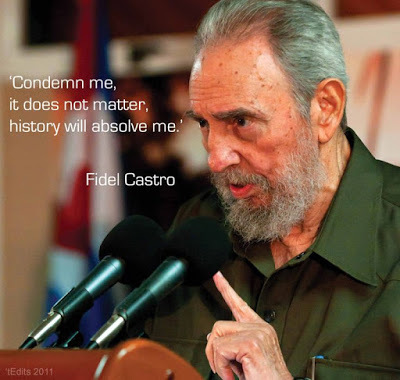
According to Castro, the revolutionaries started reorganizing with only two rifles, but by early 1957 they were already attracting recruits and winning small battles against Rural Guard patrols. “We’d take out the men in front, attack the center, and then ambush the rear when it started retreating, in the terrain we’d chosen,” Castro said in his spoken autobiography. In 1958, Batista tried to snuff out the uprising with a massive offensive, complete with air force bombers and naval offshore units. The guerrillas held their ground, launched a counterattack and wrested control from Batista on January 1, 1959. Castro arrived in Havana a week later and soon took over as prime minister. At the same time, revolutionary tribunals began trying and executing members of the old regime for alleged war crimes.
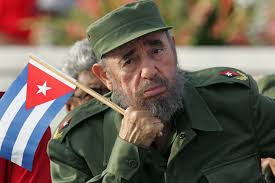
Castro’s Rule
In 1960, Castro nationalized all U.S.-owned businesses, including oil refineries, factories and casinos. This prompted the United States to end diplomatic relations and impose a trade embargo that still stands today. Meanwhile, in April 1961, about 1,400 Cuban exiles trained and funded by the CIA landed near the Bay of Pigs with the intent of overthrowing Castro. Their plans ended in disaster, however, partially because a first wave of bombers missed their targets and a second air strike was called off. Ultimately, more than 100 exiles were killed and nearly everyone else was captured. In December 1962, Castro freed them in exchange for medical supplies and baby food worth about $52 million.
Castro publicly declared himself a Marxist-Leninist in late 1961. By that time, Cuba was becoming increasingly dependent on the Soviet Union for economic and military support. In October 1962, the United States discovered that nuclear missiles had been stationed there, just 90 miles from Florida, setting off fears of a World War III. After a 13-day standoff, Soviet leader Nikita Khrushchev agreed to remove the nukes against the wishes of Castro, who was left out of the negotiations. In return, U.S. President John F. Kennedy publicly consented not to reinvade Cuba and privately consented to take American nuclear weapons out of Turkey.
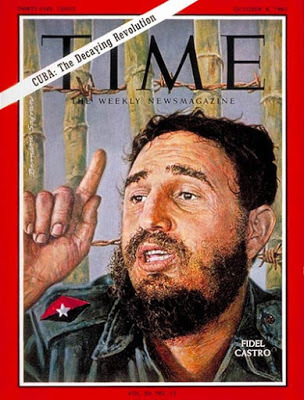
Cuban Life under Castro
After taking power, Castro abolished legal discrimination, brought electricity to the countryside, provided for full employment and advanced the causes of education and health care, in part by building new schools and medical facilities. But he also closed down opposition newspapers, jailed thousands of political opponents and made no move toward elections. Moreover, he limited the amount of land a person could own, abolished private business and presided over housing and consumer goods shortages. With political and economic options so limited, hundreds of thousands of Cubans, including vast numbers of professionals and technicians, left Cuba, often for the United States.
From the 1960s to the 1980s, Castro supplied military and financial aid to various leftist guerilla movements in Latin America and Africa. Nonetheless, relations with many countries, with the notable exception of the United States, began to normalize. Cuba’s economy foundered when the Soviet Union collapsed in the early 1990s and the United States expanded sanctions even further. Yet Castro, who by this time had switched his title from prime minister to president, found new trading partners and was able to cling to power until 2006, when he temporarily gave control of the government to Raúl after undergoing emergency intestinal surgery. Two years later, in 2008, he permanently resigned.
In 2015, U.S. and Cuban officials announced they had agreed to terms on the normalization of relations between the two nations, with mutual embassies and diplomatic missions opening in each country.
Castro died on November 25, 2016, at the age of 90. His death was announced on state television and later confirmed by his brother Raúl.
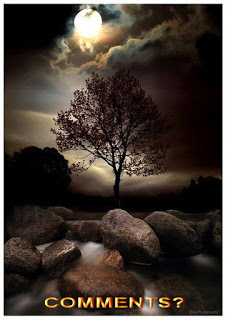
Clancy's comment: I've read that he survived more than 600 assassination attempts; most by the CIA.
I'm ....


Published on October 10, 2017 13:26
October 9, 2017
10 October 2017 - MOVING PICTURES

MOVING PICTURES
G'day folks,
Time to check out some more amazing moving pictures.











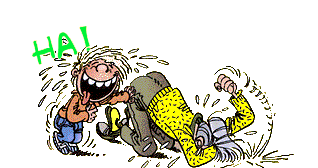



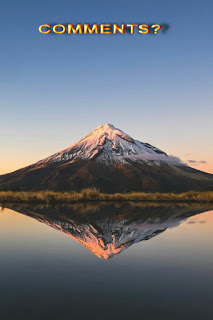 Clancy's comment: I love the kangaroo chasing the chick on the beach. It happens to me all the time.
Clancy's comment: I love the kangaroo chasing the chick on the beach. It happens to me all the time.I'm ...

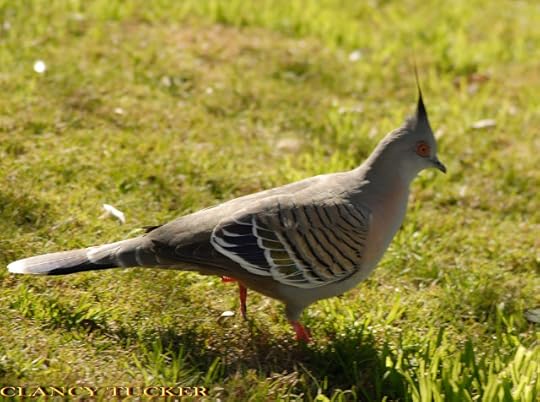
Published on October 09, 2017 13:33



